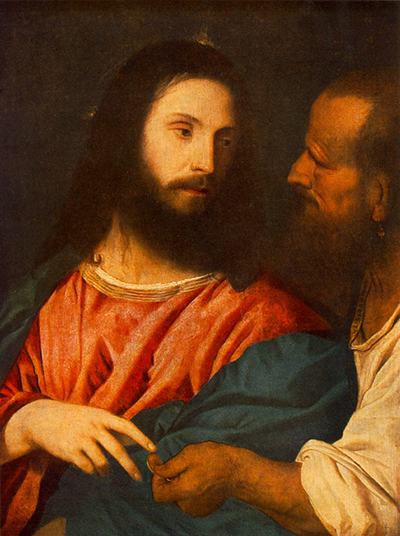The Tribute Money is a panel painting of 1516. The painting is an art work of the late Italian Renaissance artist Titian. The Tribute Money painting is now in Gemäldegalerie Alte Meister in Dresden, Germany.
This work was commissioned by Alfonso I d'Este, Duke of Ferrara and it had a personal significance to him. The painting shows Christ and a certain Pharisee at a Bible moment when Christ is shown a coin and then he says “Give to Caesar what belongs to Caesar and give God what belongs to God”. On the left side of the Pharisee's collar it is signed Ticianus F. [ecit].
The painting of Tribute Money by Titian can be dated with great confidence. Since the work was commissioned by someone who is known, Titian and his two assistants pent some 5 weeks staying at Castello Estense in Ferrara which is owned by Alfonso. They stayed there from 22 February to the end of March 1516. Titian was known for painting on canvas but this painting had an original use as a door. In the coming years the duke became an important patron of Titian because his first commission impressed him.
On another side of the story, it is revealed that the painting had a story with a political relevance. The duke had territories that were partly in the Papal States and partly in the Holy Roman Empire which gave a particular meaning to him. The trap that was set to Christ was the same as the one that the duke has been facing for several years. Alfonso the duke took the message of Christ's injunction that is in the Tribute Money painting. He took it as if he was being told to concentrate on church matters instead of expanding his territories. The part of the gospel text of the narrative’s episode was included as the gold coin that is on the Tribute Money painting.
The Tribute Money painting has been defined as Titian's sleekest and most polished early work. This is one of the reasons the painting became famous. Some of the best artists referred to it as Titian's most perfect painting. Later, Titian had to paint a bigger composition of the subject and this is probably due to the demand for the painting's replicas. The later version’s work began around 1543 but it was completed in the 1560's. In 1568 the painting was sent to Philip II of Spain. After some x-radiographs were performed, it was revealed that the gold coin in the painting was originally inscribed with Ferrara.
Titian in his late 20’s claimed that the Pharisee's figure was a self-portrait. This same claim has gone on in narrative scenes that were done by Titian. The Tribute Money is an example of a narrative subject drawing on the artist’s skill as a portraitist. The painting is on an oil medium and it has the dimensions of 75 cm × 56 cm (30 in × 22 in).




